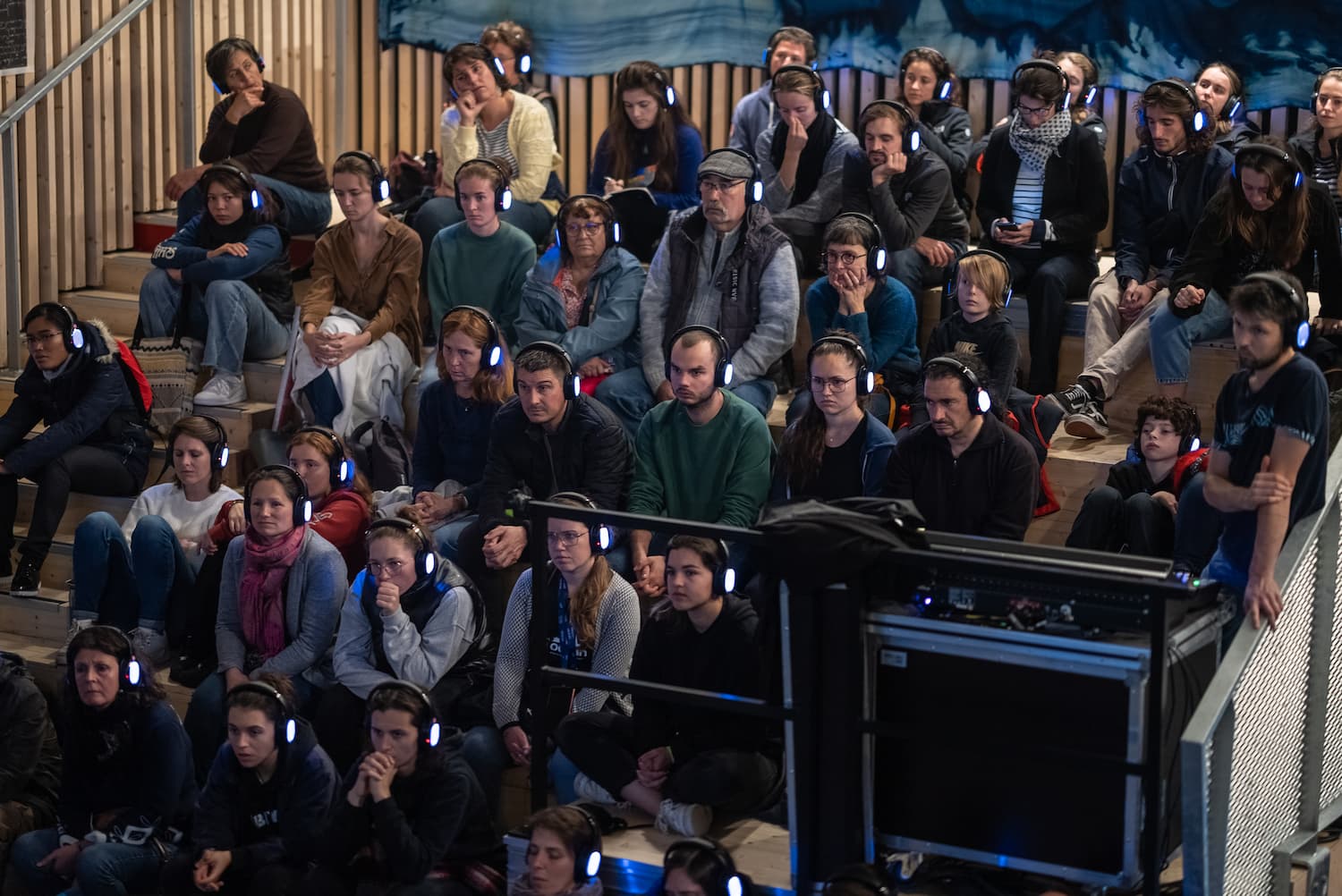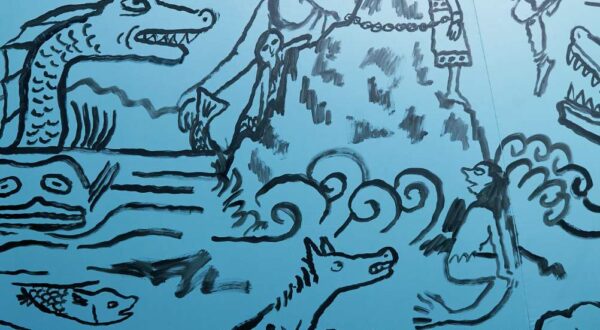BECOMING OCEAN, a social conversation with the Ocean.
At the heart of the theme of the 2025 Nice Biennale, The Sea Around Us, the exhibition "Becoming Ocean: a social conversation about the Ocean" echoes the 3rd United Nations Ocean Conference held there in June.
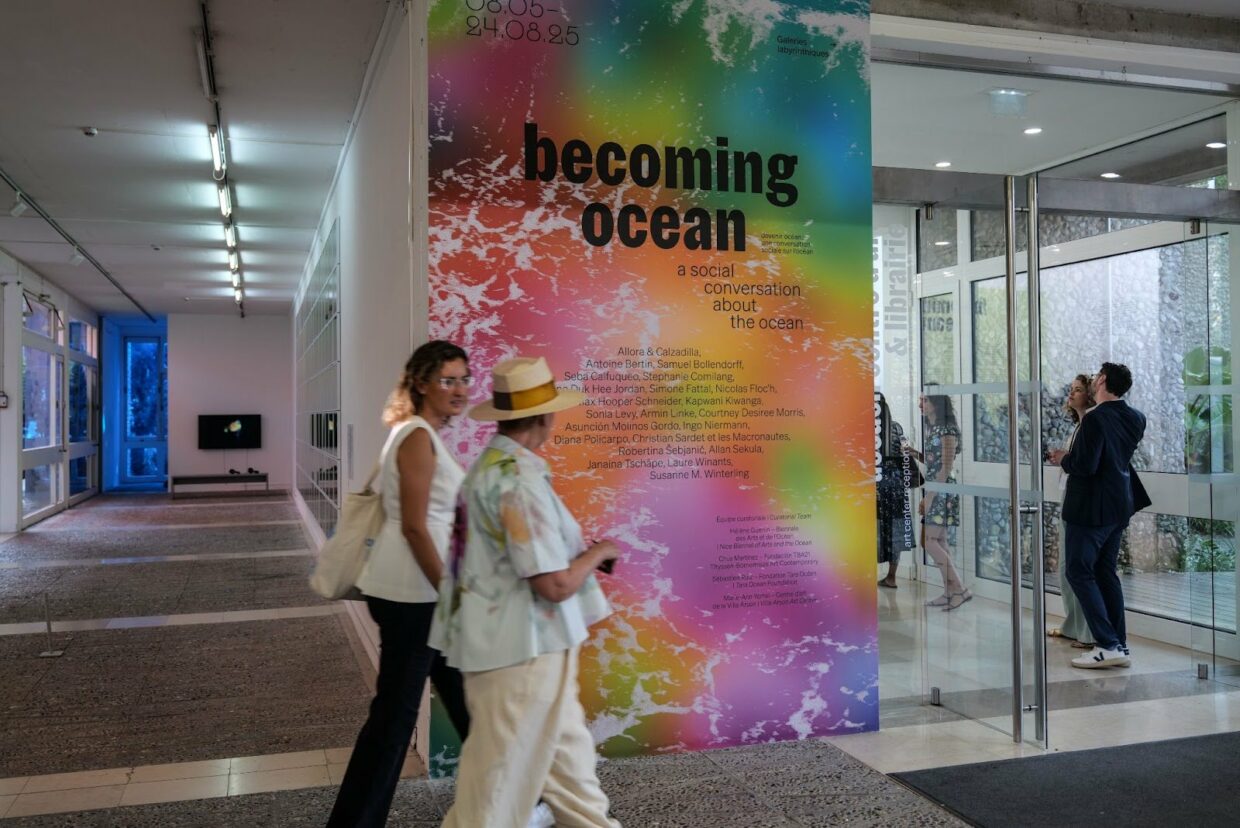
The result of unprecedented and transdisciplinary collaborations, the exhibition brings together works by more than twenty international artists from the TBA21 Thyssen-Bornemisza Art Contemporary collection, and artists in residence from the Tara Ocean Foundation, in collaboration with the Schmidt Ocean Institute. Becoming Ocean offers us the opportunity for different territories and visions to coexist through critical and documentary approaches, as well as more sensory, poetic, or speculative expressions.
It is part of an urgent environmental context and aims to initiate a social conversation about the critical state of the Ocean and our collective responsibility, by rethinking our connection to the Ocean and marine ecosystems.
The Ocean as a place for dialogue: a committed curatorial approach
1 – The Ocean as a global issue
The exhibition questions our relationship with the ocean through 5 themes at the heart of our societal problems:
- overfishing,
- pollution,
- deep sea mining,
- maritime traffic,
- biodiversity.
It contributes to a necessary collective awareness of the essential role of the Ocean.
Making visible the consequences of overfishing, chemical and noise pollution, the intensification of maritime transport, or the threats posed by deep-sea mining, aims to reinvent a contemporary relationship with the Ocean.
2 – Crossing disciplines to face the urgency
Becoming Ocean is a collective reflection on what we know, ignore, or forget about the Ocean – and on the forms of attention its future demands of us. Through artistic, political, and scientific perspectives, the exhibition initiates an open dialogue on the upheavals affecting the Ocean and the peoples who depend on it.
The exhibition mixes installations, photographs, sculptures, and films. It invites us to take a step back by integrating mythical, scientific, and committed narratives while highlighting the urgency of rethinking our relationship with this vital ecosystem.
3 – The Ocean at the heart of human cultures and histories
The exhibition journey opens with an installation by Courtney Desiree Morris: an altar mixing offerings, ancestral symbols, and ancestral memory. This ritual threshold reminds us that the Ocean is a sacred space for many cultures, a place of birth, passage, and resistance to territorial conquest.
Artists Armin Linke, Seba Calfuqueo, and Kapwani Kiwanga then address the most destructive aspects of this link between human populations and the Ocean, in the light of capitalist systems: deep-sea mining projects, industrial overfishing, and resource grabbing.
The link between the Ocean and humanity appears here as a reflection of our social, economic, cultural, and political history.
4 – Toxicity and invisibility of pollution
Another toxic consequence of our current relationship with the Ocean is, of course, pollution, omnipresent and diversified, most often invisible.
Some works directly document these realities. The artist Samuel Bollendorff* reveals the pollution that permeates marine landscapes beneath their apparent beauty: his samples rigorously and alarmingly bear witness to this.
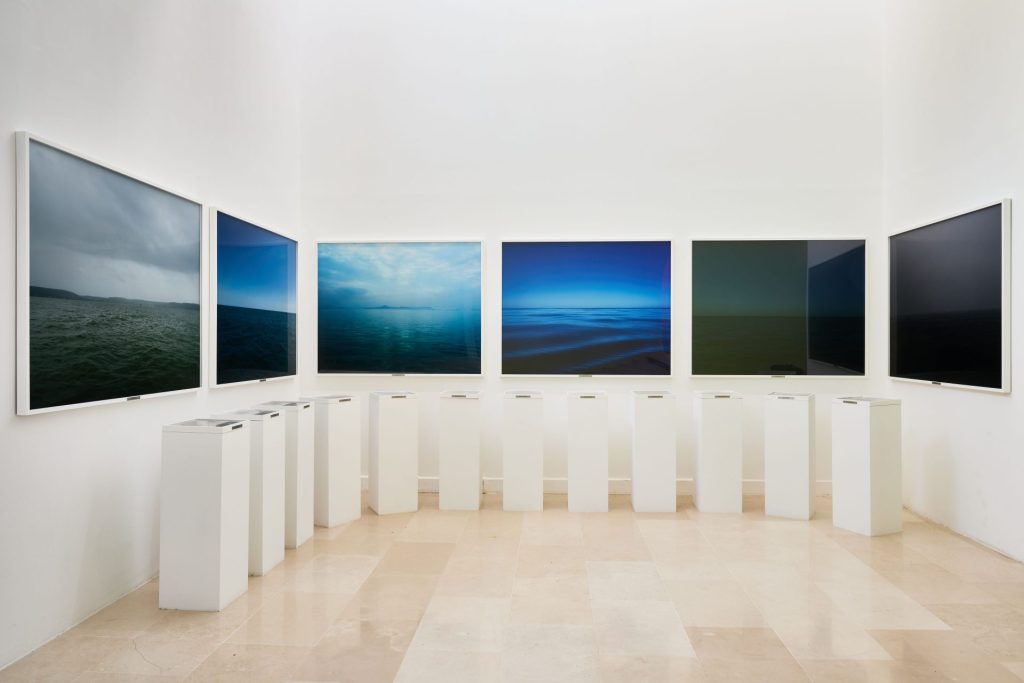
The artist Laure Winants shows the chemical contamination of water using experimental devices, while Robertina Šebjanič*, with her artistic installation [Echoes from the Abyss], explores the toxic effects of submerged weapons. Her projects are a call for the development of new collective strategies based on empathy for a better recognition of living things. Art becomes a tool for investigation.
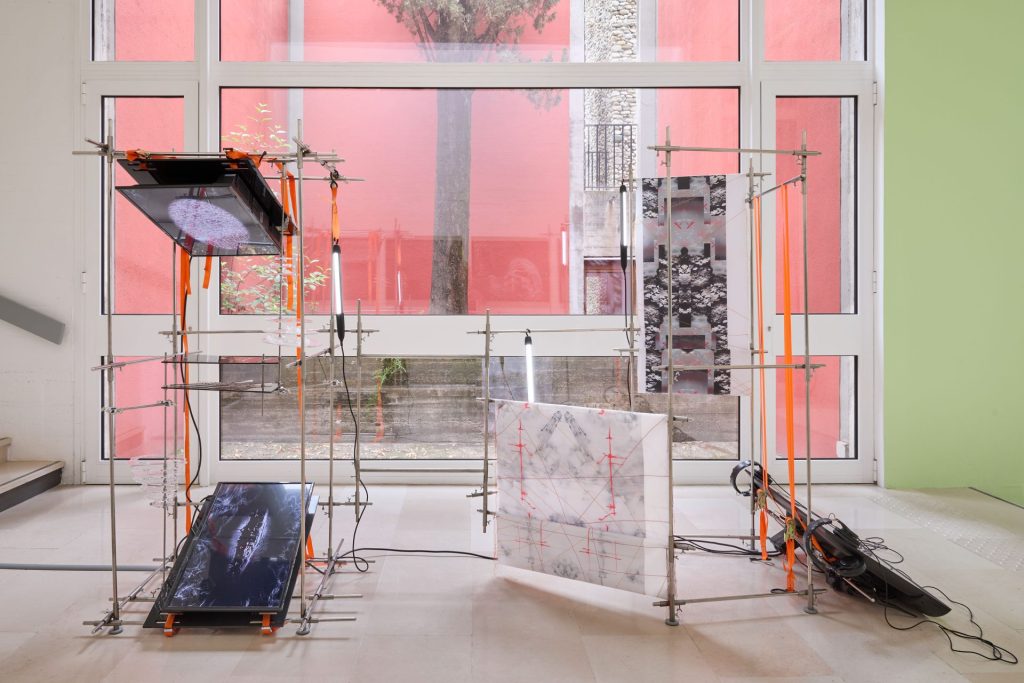
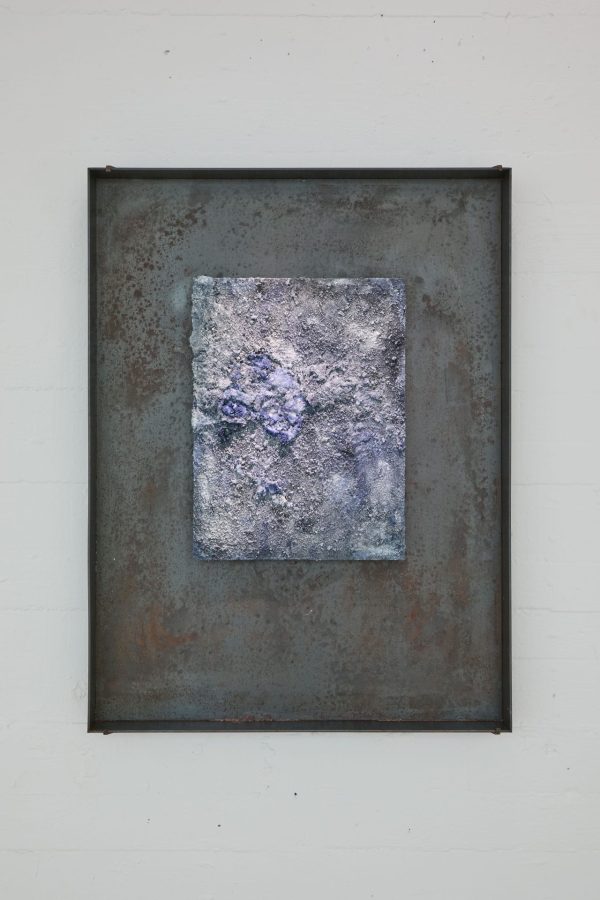
5 – Imagining a restorative relationship with the Ocean
Gemini
Autres options
Développer
Fermer
Modifier le texte
traduire ce texte en anglais
Photo gallery:
BECOMING OCEAN, a social conversation with the Ocean. Lead-in
At the heart of the theme of the 2025 Nice Biennale, The Sea Around Us, the exhibition “Becoming Ocean: a social conversation about the Ocean” echoes the 3rd United Nations Ocean Conference held there in June.
The result of unprecedented and transdisciplinary collaborations, the exhibition brings together works by more than twenty international artists from the TBA21 Thyssen-Bornemisza Art Contemporary collection, and artists in residence from the Tara Ocean Foundation, in collaboration with the Schmidt Ocean Institute.
Becoming Ocean offers us the opportunity for different territories and visions to coexist through critical and documentary approaches, as well as more sensory, poetic, or speculative expressions.
It is part of an urgent environmental context and aims to initiate a social conversation about the critical state of the Ocean and our collective responsibility, by rethinking our connection to the Ocean and marine ecosystems.
Button link to the Villa Arson website: https://villa-arson.fr/programmation/expositions/becoming-ocean-a-social-conversation-about-the-ocean/
The Ocean as a place for dialogue: a committed curatorial approach
1 The Ocean as a global issue:
The exhibition questions our relationship with the ocean through 5 themes at the heart of our societal problems: overfishing, pollution, seabed mining, maritime traffic, and biodiversity. It contributes to a necessary collective awareness of the essential role of the Ocean.
Making visible the consequences of overfishing, chemical and noise pollution, the intensification of maritime transport, or the threats posed by deep-sea mining, aims to reinvent a contemporary relationship with the Ocean.
2 Crossing disciplines to face the urgency
Becoming Ocean is a collective reflection on what we know, ignore, or forget about the Ocean – and on the forms of attention its future demands of us. Through artistic, political, and scientific perspectives, the exhibition initiates an open dialogue on the upheavals affecting the Ocean and the peoples who depend on it.
The exhibition mixes installations, photographs, sculptures, and films. It invites us to take a step back by integrating mythical, scientific, and committed narratives while highlighting the urgency of rethinking our relationship with this vital ecosystem.
3 The Ocean at the heart of human cultures and histories
The exhibition journey opens with an installation by Courtney Desiree Morris: an altar mixing offerings, ancestral symbols, and ancestral memory. This ritual threshold reminds us that the Ocean is a sacred space for many cultures, a place of birth, passage, and resistance to territorial conquest.
Artists Armin Linke, Seba Calfuqueo, and Kapwani Kiwanga then address the most destructive aspects of this link between human populations and the Ocean, in the light of capitalist systems: deep-sea mining projects, industrial overfishing, and resource grabbing.
The link between the Ocean and humanity appears here as a reflection of our social, economic, cultural, and political history.
4 Toxicity and invisibility of pollution
Another toxic consequence of our current relationship with the Ocean is, of course, pollution, omnipresent and diversified, most often invisible.
Some works directly document these realities. The artist Samuel Bollendorff* reveals the pollution that permeates marine landscapes beneath their apparent beauty: his samples rigorously and alarmingly bear witness to this.
The artist Laure Winants shows the chemical contamination of water using experimental devices, while Robertina Šebjanič*, with her artistic installation [Echoes from the Abyss], explores the toxic effects of submerged weapons. Her projects are a call for the development of new collective strategies based on empathy for a better recognition of living things. Art becomes a tool for investigation.
Photo Samuel Bollendorff – Laure and Robertina
5 Imagining a restorative relationship with the Ocean
While Becoming Ocean directly exposes the wounds inflicted on the Ocean, it is not limited to a grim assessment. On the contrary, many works invite us to repair, regenerate, and relearn how to coexist with the marine world, thus offering a powerful message of hope.
This is the case with the work of Nicolas Floc’h*, who questions our legitimacy to intervene in marine ecosystems, while highlighting the risks associated with the artificial reconstitution of biodiversity. His work, like others, emphasizes the urgency of upstream action, before points of no return are reached.
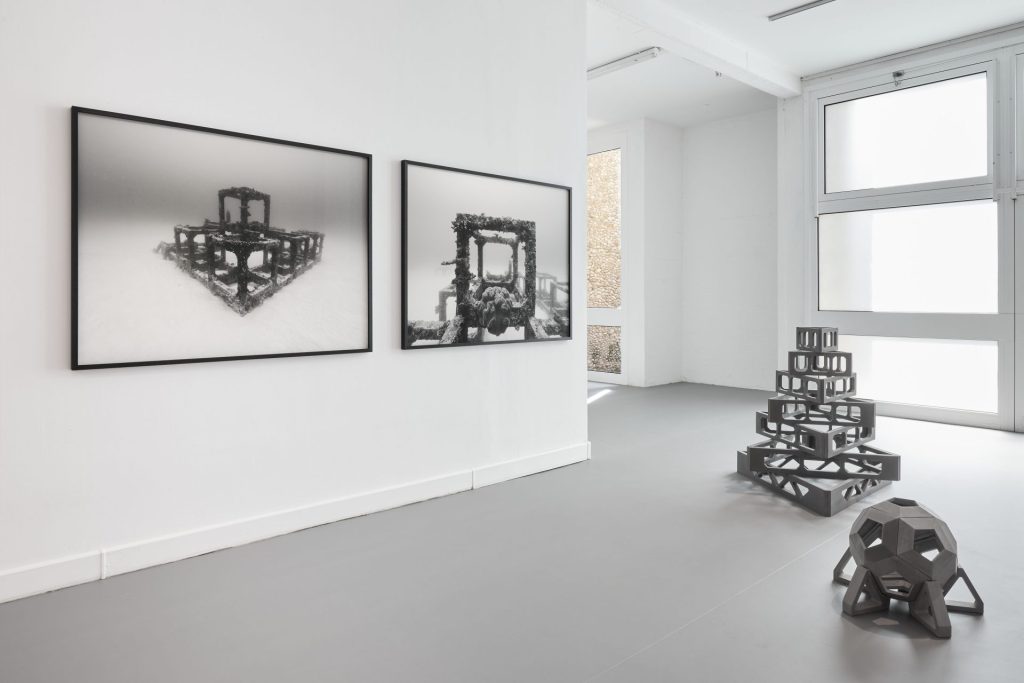
6 – Towards a sensitive and poetic ecology of the Ocean
Other works offer a more sensory and celebratory approach. This is the case with the creations of Anne Duk Hee Jordan, Christian Sardet*, Antoine Bertin*, or the video Sea Lovers (2002) by Ingo Niermann, which proposes a more intimate, almost loving relationship with the Ocean.
Artists Antoine Bertin and Christian Sardet were residents aboard the Tara schooner.
Antoine Bertin, with Conversation métabolite and Choeur de poissons, offers us listening experiences, immersive moments, and sound meditations to explore our relationships with the living world. Christian Sardet, for his part, uses photography and video to reveal the beauty of this invisible people, plankton.
Works that celebrate a sensitive and respectful connection with the Ocean.
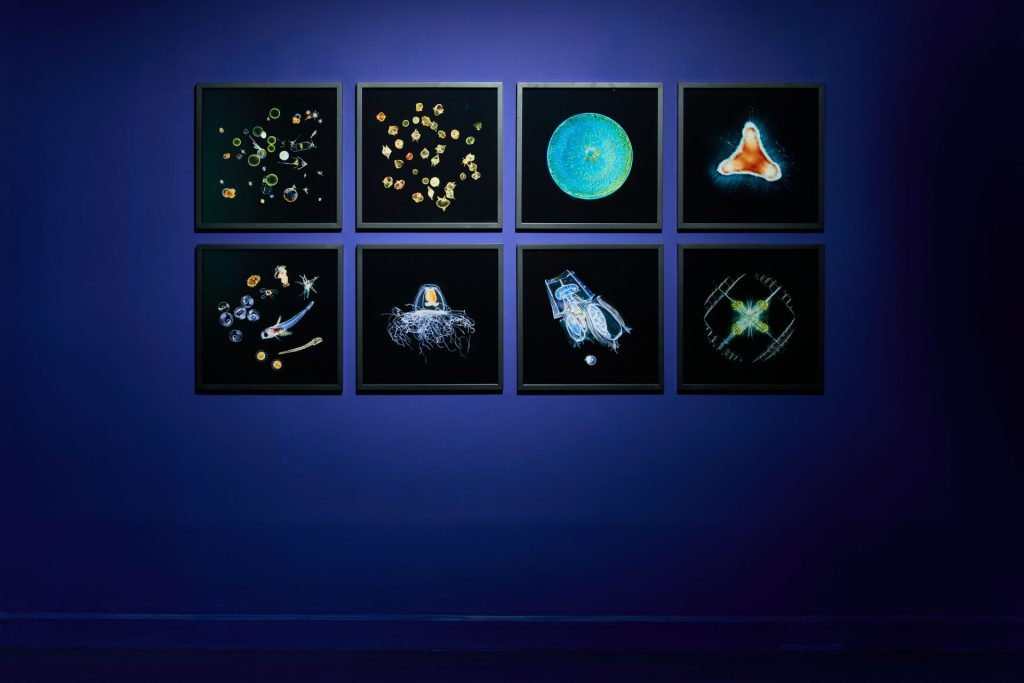
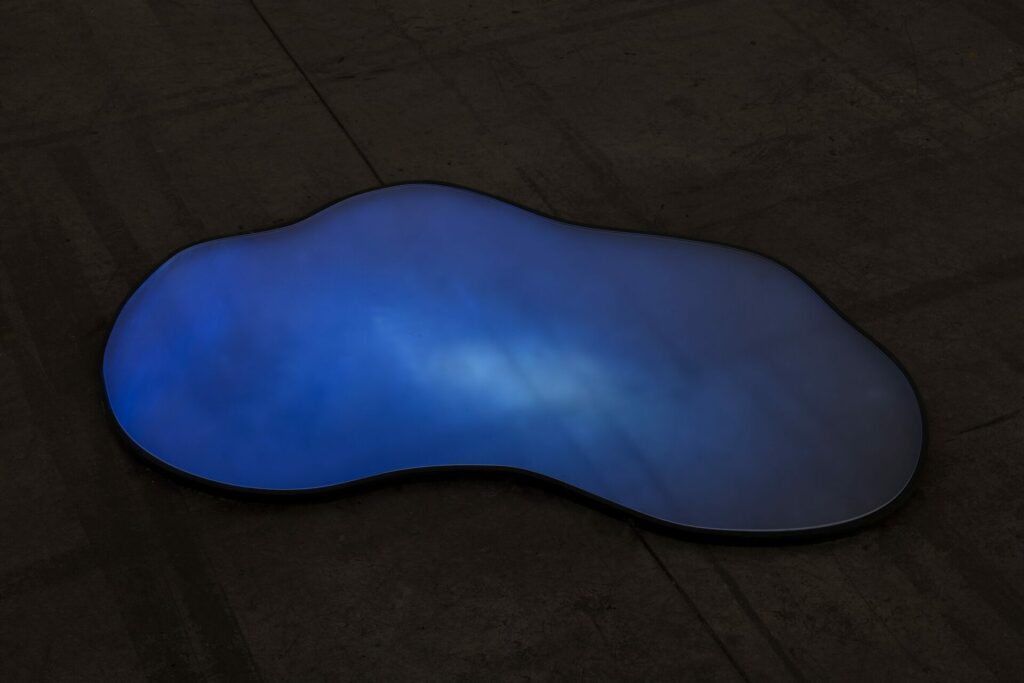
Art as a vector of change
Artists translate complex phenomena (climate crisis, extractivism) into sensitive narratives, mixing scientific and personal perspectives.
Their works denounce human impacts while proposing alternative visions.
The exhibition Becoming Ocean, a social conversation about the Ocean does not merely denounce: it calls for a radical transformation of our relationship with the Ocean, by combining art, science, and environmental justice to inspire a future that is more respectful of living things.
Reinventing our connection to the Ocean
But can we imagine another relationship?
For several decades, artists have played a central role in understanding the world around us. By transforming global and abstract phenomena into embodied narratives, interdisciplinary collaborations, or critical proposals, they create bridges between past and future.
Becoming Ocean invites us to consider the Ocean not as a resource to be exploited, but as a subject, an ally, a territory of living relationships to be reinvented with shared responsibility.
Gemini
Autres options
Développer
Fermer
Modifier le texte
traduire ce texte en anglais
Photo gallery:
BECOMING OCEAN, a social conversation with the Ocean. Lead-in
At the heart of the theme of the 2025 Nice Biennale, The Sea Around Us, the exhibition “Becoming Ocean: a social conversation about the Ocean” echoes the 3rd United Nations Ocean Conference held there in June.
The result of unprecedented and transdisciplinary collaborations, the exhibition brings together works by more than twenty international artists from the TBA21 Thyssen-Bornemisza Art Contemporary collection, and artists in residence from the Tara Ocean Foundation, in collaboration with the Schmidt Ocean Institute.
Becoming Ocean offers us the opportunity for different territories and visions to coexist through critical and documentary approaches, as well as more sensory, poetic, or speculative expressions.
It is part of an urgent environmental context and aims to initiate a social conversation about the critical state of the Ocean and our collective responsibility, by rethinking our connection to the Ocean and marine ecosystems.
Button link to the Villa Arson website: https://villa-arson.fr/programmation/expositions/becoming-ocean-a-social-conversation-about-the-ocean/
The Ocean as a place for dialogue: a committed curatorial approach
1 The Ocean as a global issue:
The exhibition questions our relationship with the ocean through 5 themes at the heart of our societal problems: overfishing, pollution, seabed mining, maritime traffic, and biodiversity. It contributes to a necessary collective awareness of the essential role of the Ocean.
Making visible the consequences of overfishing, chemical and noise pollution, the intensification of maritime transport, or the threats posed by deep-sea mining, aims to reinvent a contemporary relationship with the Ocean.
2 Crossing disciplines to face the urgency
Becoming Ocean is a collective reflection on what we know, ignore, or forget about the Ocean – and on the forms of attention its future demands of us. Through artistic, political, and scientific perspectives, the exhibition initiates an open dialogue on the upheavals affecting the Ocean and the peoples who depend on it.
The exhibition mixes installations, photographs, sculptures, and films. It invites us to take a step back by integrating mythical, scientific, and committed narratives while highlighting the urgency of rethinking our relationship with this vital ecosystem.
3 The Ocean at the heart of human cultures and histories
The exhibition journey opens with an installation by Courtney Desiree Morris: an altar mixing offerings, ancestral symbols, and ancestral memory. This ritual threshold reminds us that the Ocean is a sacred space for many cultures, a place of birth, passage, and resistance to territorial conquest.
Artists Armin Linke, Seba Calfuqueo, and Kapwani Kiwanga then address the most destructive aspects of this link between human populations and the Ocean, in the light of capitalist systems: deep-sea mining projects, industrial overfishing, and resource grabbing.
The link between the Ocean and humanity appears here as a reflection of our social, economic, cultural, and political history.
4 Toxicity and invisibility of pollution
Another toxic consequence of our current relationship with the Ocean is, of course, pollution, omnipresent and diversified, most often invisible.
Some works directly document these realities. The artist Samuel Bollendorff* reveals the pollution that permeates marine landscapes beneath their apparent beauty: his samples rigorously and alarmingly bear witness to this.
The artist Laure Winants shows the chemical contamination of water using experimental devices, while Robertina Šebjanič*, with her artistic installation [Echoes from the Abyss], explores the toxic effects of submerged weapons. Her projects are a call for the development of new collective strategies based on empathy for a better recognition of living things. Art becomes a tool for investigation.
Photo Samuel Bollendorff – Laure and Robertina
5 Imagining a restorative relationship with the Ocean
While Becoming Ocean directly exposes the wounds inflicted on the Ocean, it is not limited to a grim assessment. On the contrary, many works invite us to repair, regenerate, and relearn how to coexist with the marine world, thus offering a powerful message of hope.
This is the case with the work of Nicolas Floc’h*, who questions our legitimacy to intervene in marine ecosystems, while highlighting the risks associated with the artificial reconstitution of biodiversity. His work, like others, emphasizes the urgency of upstream action, before points of no return are reached.
Photo Nicolas Floc’h – artificial reefs
6 Towards a sensitive and poetic ecology of the Ocean
Other works offer a more sensory and celebratory approach. This is the case with the creations of Anne Duk Hee Jordan, Christian Sardet*, Antoine Bertin*, or the video Sea Lovers (2002) by Ingo Niermann, which proposes a more intimate, almost loving relationship with the Ocean.
Artists Antoine Bertin and Christian Sardet were residents aboard the Tara schooner.
Antoine Bertin, with Conversation métabolite and Choeur de poissons, offers us listening experiences, immersive moments, and sound meditations to explore our relationships with the living world. Christian Sardet, for his part, uses photography and video to reveal the beauty of this invisible people, plankton.
Works that celebrate a sensitive and respectful connection with the ocean.
Photos Christian Sardet / Antoine Bertin
Art as a vector of change
Artists translate complex phenomena (climate crisis, extractivism) into sensitive narratives, mixing scientific and personal perspectives.
Their works denounce human impacts while proposing alternative visions.
The exhibition Becoming Ocean, a social conversation about the Ocean does not merely denounce: it calls for a radical transformation of our relationship with the Ocean, by combining art, science, and environmental justice to inspire a future that is more respectful of living things.
Reinventing our connection to the Ocean
But can we imagine another relationship?
For several decades, artists have played a central role in understanding the world around us. By transforming global and abstract phenomena into embodied narratives, interdisciplinary collaborations, or critical proposals, they create bridges between past and future.
Becoming Ocean invites us to consider the Ocean not as a resource to be exploited, but as a subject, an ally, a territory of living relationships to be reinvented with shared responsibility.
Feeling, imagining, regenerating, aspires to awaken in us the desire for new ways of life that artists allow us to glimpse.
Artists marked with an asterisk in this article have been hosted aboard the Tara schooner over the past twenty years. Their works were also highlighted during the exhibition “Tara, art and science to reveal the Ocean,” presented at CENTQUATRE-PARIS.
Villa Arson
The Villa Arson, under the tutelage of the Ministry of Culture and affiliated with Université Côte d’Azur since 2020, is a unique institution dedicated to contemporary creation. Conceived in the 1960s by André Malraux and inaugurated in 1972, it brings together an art school, a contemporary art center, residencies, a library, and a research hub. Its model is based on the articulation of these activities, allowing its 230 students to benefit from an environment conducive to experimentation, production, and dissemination. The art center develops an international program focused on emerging creation. Listed as a Historic Monument and labeled “Remarkable Contemporary Architecture,” Villa Arson embodies a strong ambition: to connect artistic education, research, and living creation.
TBA21
TBA21 – Thyssen-Bornemisza Art Contemporary is an international foundation created in 2002 by Francesca Thyssen-Bornemisza, dedicated to art, research, and public action. Based in Madrid, with branches in Venice and Portland (Jamaica), it manages an important collection of contemporary art and develops exhibitions, educational programs, and research projects. Through its TBA21–Academy branch, the foundation conducts transdisciplinary initiatives focused on marine ecologies and environmental issues. As an observer to the International Seabed Authority (ISA), it advocates for the integration of art into public policy and environmental governance processes.
Schmidt Océan Institute
The Schmidt Ocean Institute, founded in 2009 by Eric and Wendy Schmidt, supports innovative scientific research to better understand the Ocean and protect the planet. Its Artist-at-Sea program, launched in 2015, invites artists to collaborate with scientists aboard the research vessel Falkor (too). This interdisciplinary approach fosters new perspectives and strengthens our connection with the marine world, by sharing discoveries and knowledge for a sustainable future.
Fondation Tara Océan
The Tara Ocean Foundation, the first French foundation dedicated to the Ocean, has been working for over 20 years to preserve marine life. It conducts international scientific expeditions to study biodiversity and the impacts of climate change, while raising public and decision-maker awareness. A special observer at the UN, it participates in global ocean governance. In parallel, since 2004, the Foundation has supported artistic residencies aboard its schooner, where more than fifty artists from various disciplines (painting, photography, sculpture, video, writing, etc.) have been able to create in immersion. These residencies make the invisible visible, renew the perception of the Ocean, and establish a dialogue between art and science.
